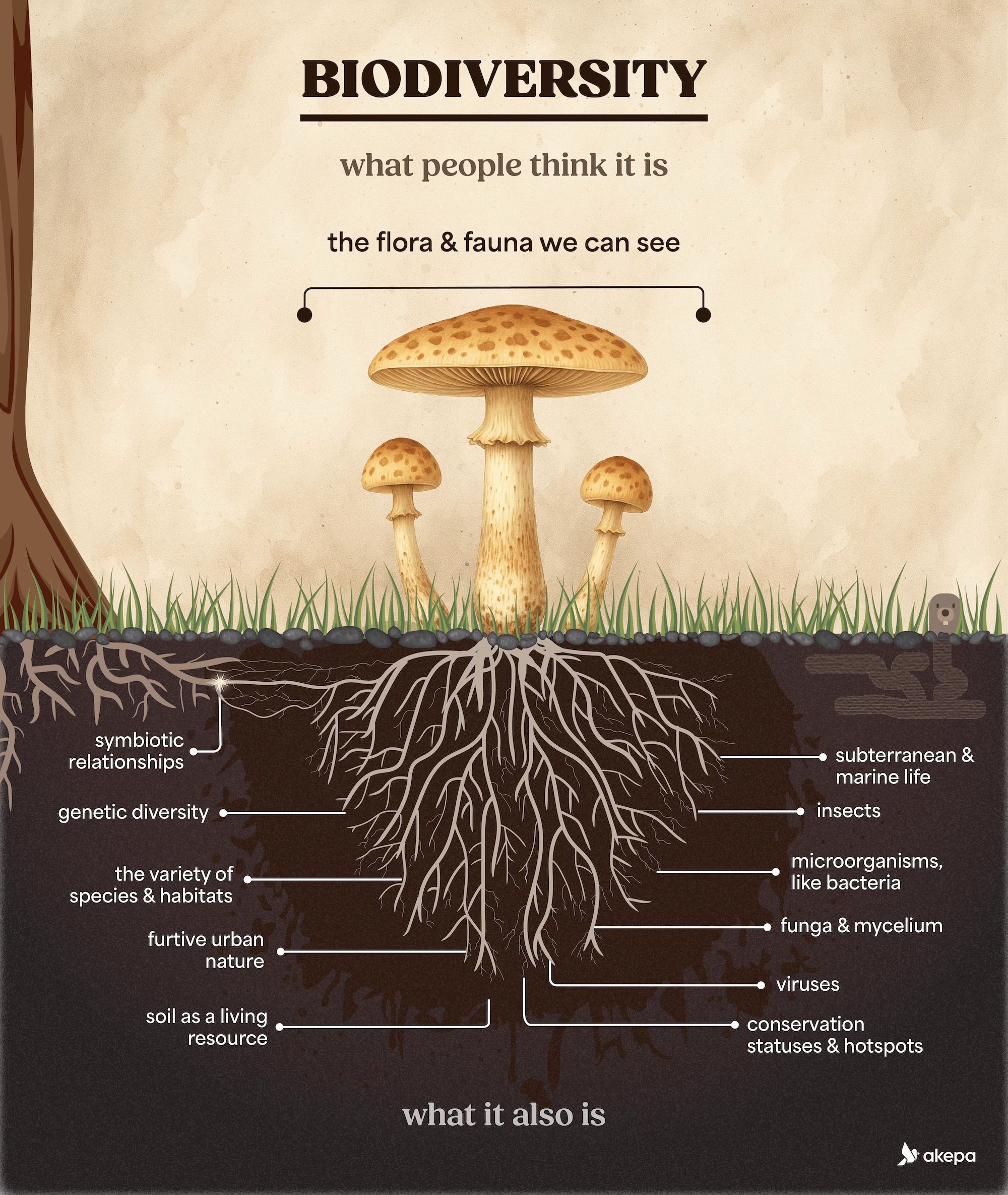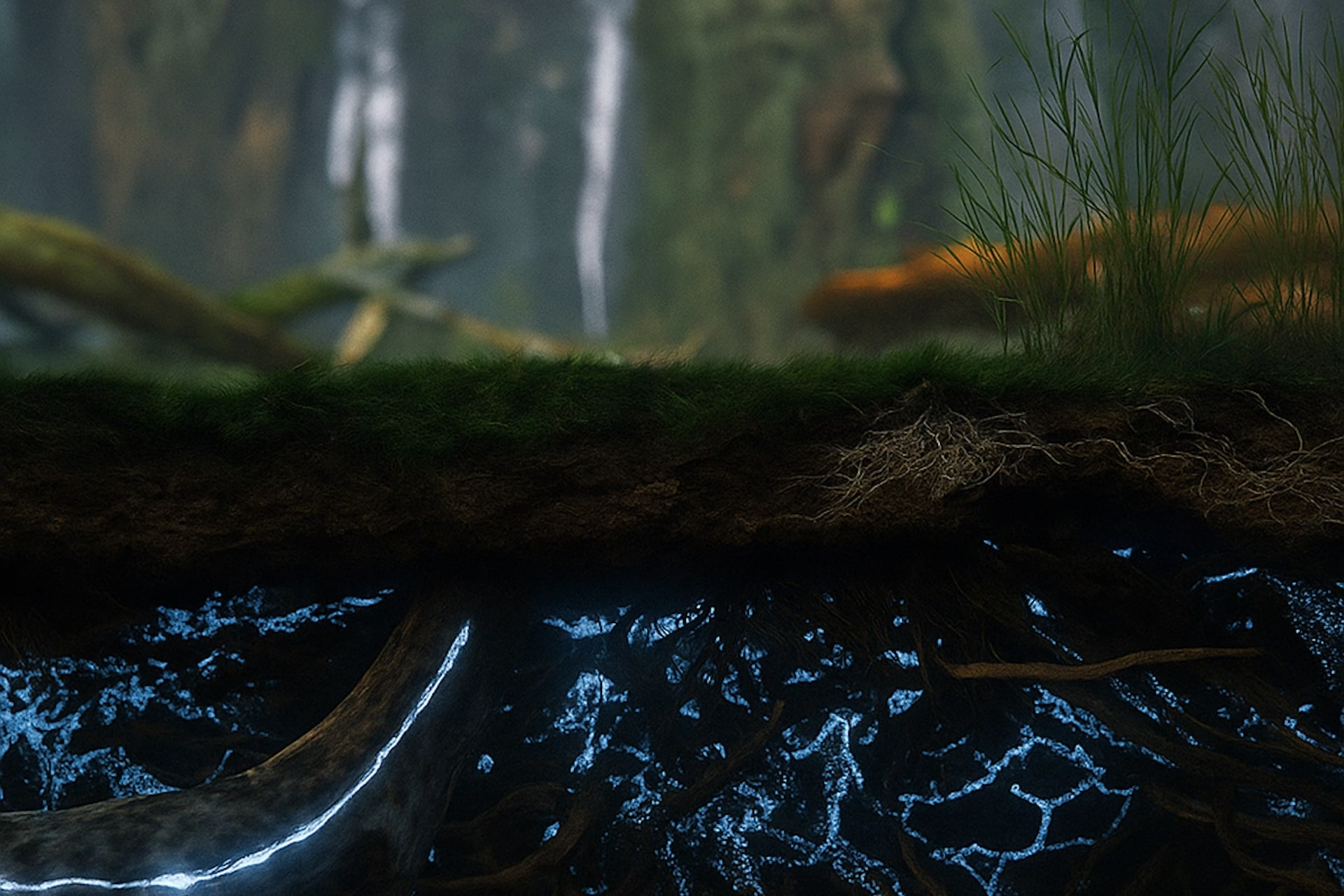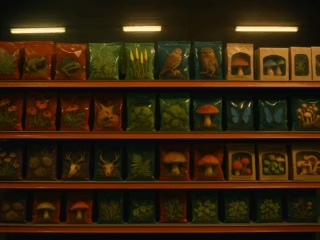Last year, we wrote about the Iceberg of Sustainability – exploring sustainability’s profundities in a way that made visual and figurative sense.
Now, we’re taking a step further into the wild and looking at The Mushroom of Biodiversity. Our aim is to explore the rich, hidden depths of this other important but misunderstood term – through the narrative device of a fungus.
And a fungus is apt to bring to the table. The world’s flora and fauna are now considered by many to be better described as flora, fauna and funga – with negotiations on awarding fungi an elevated status taking place at the latest biodiversity COPs. Just like an iceberg, the fruiting mushroom is merely the tip of a vast system that exists underneath. Some mycelial networks are known to extend up to 10km2, making fungal networks the largest known living organism on earth. Yes, far bigger than even a Blue Whale or a Brontosaurus.
Are we boring you? Well, without further waffling, let’s get to it. First the infographic and then we’ll explain each aspect in the post yonder…

Is any of that unexpected? Some of these aspects might seem obvious to you but with 41% of people in the EU not understanding the term, according to the European Environment Agency, they should be surprising to some humans.
Now let’s look at each of those areas in a little more detail and why biodiversity includes them…
Remember, these issues aren’t isolated and are rather interconnected, like an ecosystem. Take the health of the soil, which is influenced by the insects within it, which in turn are helped by the mycelium in the soil, which they eat – and so on!
1. Symbiotic relationships
There are many symbiotic relationships within nature and they can underpin biodiversity. Take mushrooms, which don’t just grow in forests but help create them. Mycorrhizal fungi form underground networks with tree roots, exchanging nutrients. These relationships boost resilience, water access, and growth. Around 90% of plants depend on fungi to survive and thrive. In turn, mushrooms need trees, leaves and other nutrients that the forest provides, to grow.
2. Genetic diversity
Genetic variety within species is key to resilience. It means a species can better adapt to pests, disease, or climate stress. Without it, extinction risks soar. It’s estimated that up to 75% of crop genetic diversity has already been lost, making our food systems frighteningly fragile.
3. Variety of species and habitats
Biodiversity isn’t just about charming animals, such as otters or tree kangaroos, it’s about ecosystems in balance. Each species and habitat plays a role in pollination, climate regulation, water purification, and more. We’ve already wiped out 83% of wild mammals and half of all plants. Protecting diversity means protecting life itself.
4. Furtive urban nature
Biodiversity lives even in the cracks. Urban nature – weeds in pavements, bees on balconies, fungi in forgotten corners – boosts human wellbeing and ecological resilience. Nearly 70% of the world’s population will live in cities by 2050. Nature in cities is needed as much as roads, restaurants, concerts and buildings.
5. Soil as a living resource
Soil isn’t filth, it’s alive. A single gram can contain billions of microorganisms that recycle nutrients, store carbon, and grow our food. Yet, around 33% of global soils are degraded. Healthy soils must be protected like the real treasure they’re guarding.
6. Subterranean and marine life
What’s underground and undersea is often out of sight and out of mind but teeming with life. From deep-sea vents to root fungi, these ecosystems regulate climate and nutrient cycles. Oceans absorb 25% of our carbon emissions, and the deep biosphere hosts more life than we know. 71% of the Earth’s surface is water and the majority of life is found under the waves. The soil is home to way more carbon the atmosphere.
7. Insects
They may not be the most endearing creatures but we need them. Insects pollinate 75% of crops, break down waste, and are vital in the food chain. Insect populations have declined by over 70% in some places over the last 50 years. Losing them would be like losing the frame of the fine web of life.
8. Microorganisms, like bacteria
Microbes are the OG sustainability workers. Bacteria fix nitrogen, break down waste, ferment food, and keep ecosystems functioning. They’re crucial to health, human and planetary. And there’s more of them than us: microbes make up about 15% of all Earth’s biomass. Tiny alone, but together a real force.
8. Funga and mycelium networks
That’s right ‘funga’ – which is a term now in common use to describe the planet’s fungi, putting it on a deserved par with flora and fauna. Unbelievably, only around 10% of the planets fungi are (or you could say funga is) described by science. Underneath each fungus, be it a fly agaric or lion’s mane, you will find mycelial networks, which act like communications and nutrient pathways between fungi and other forms of biodiversity. Some researchers have even gone so far as to compare these networks to the nature’s internet, aka ‘The Wood Wide Web’.
10. Viruses
Yes, viruses, which have a bad rep that’s often deserved. They’re not all bad, though. In fact, they can help control microbial populations, drive evolution, and shape ecosystems. Marine viruses, for instance, play a key role in carbon cycling. It’s a reminder that nature is complicated and sometimes what seems harmful plays a hidden helping role.
11. Conservation statuses and hotspots
Biodiversity isn’t spread evenly. Some areas like the Amazon, Congo Basin, Southeast Asia, or even the Mediterranean are hotspots: bursting with life relative to the other parts of the earth. Yet many are under threat. Over 1 million species face extinction, according to the UN. Knowing what’s endangered and where helps us focus protection where it matters most.
Even this is just the cap of the mushroom:
Let us know if we’ve missed anything important that should be included under the fungi – and here’s a link to a similar infographic we prepared about the Iceberg of Sustainability.



Leave a Reply